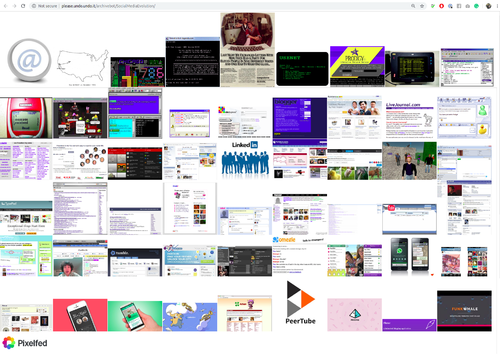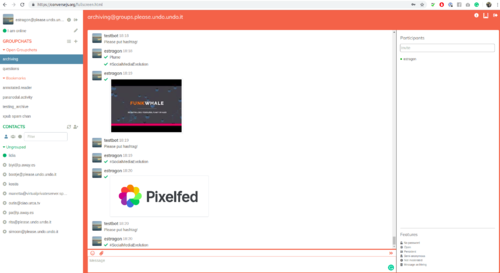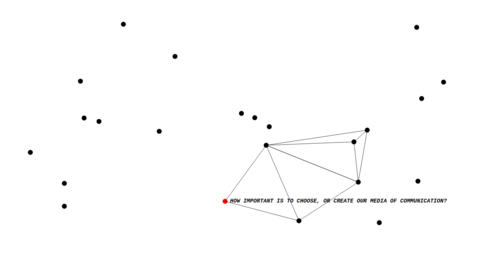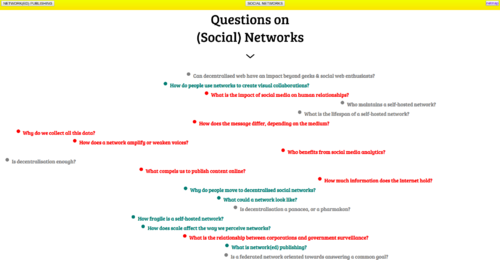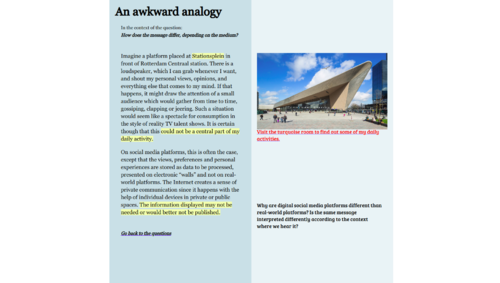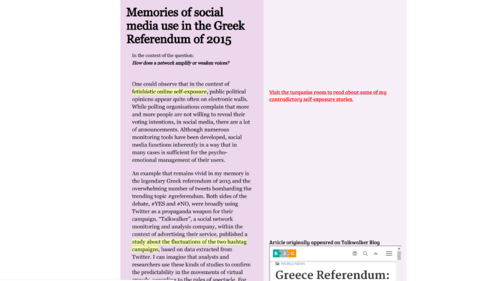User:Artemis gryllaki/PrototypingII
Personal Research
https://pad.xpub.nl/p/SI8-reflections
12/02/2019
1st prototype
Artemis
Questions on networks: Centralized/Decentralized/Federated
http://please.undo.undo.it/questions.html
Collection of the questions I had so far, presented in a webpage, and printed in A4 sheets during the Collective presentation of 12/02/2019.
<!DOCTYPE html>
<html lang="en">
<head>
<meta charset="utf-8">
<title>Questions on Networks</title>
<link rel="stylesheet" href="styleq.css">
<script src="questions.js"></script>
</head>
<header><br>
<h1>Questions on Networks</h1>
<p><span class="blink">Centralized - Decentralized </br> Federated</blink></a></p>
</header>
<main>
<br><br><br><br><br><br>
<div class="box"><h2 id="oneliner-1">QUESTIONS</h2></div>
<br>
<!--<p>Contributors: </p>-->
</main>
<footer>
</footer>
</body>
</html>
(function () {
Messages = [
"HOW CAN DECENTRALIZED WEB HAVE AN IMPACT BEYOND GEEKS, SOCIAL WEB ENTHUSIASTS & HACKERS?",
"WHY DO WE NEED A DECENTRALIZED NETWORK?",
"HOW DO WE PERCEIVE FEDERATED PUBLISHING?",
"WHAT IS THE CONTENT WE WANT TO PRODUCE?",
"COLLECTIVITY VS INDIVIDUALITY: DOES DECENTRALIZATION HELPS?",
"WHO MAKES A FEDERATED NETWORK? FOR WHO? WHY? HOW?",
"WHAT CONTENT DOES A FEDERATED NETWORK HOST?",
"IS THE MEDIUM THE MESSAGE?",
"DOES THE MEDIUM TRANSFORM THE MESSAGE?",
"DOES THE SAME STORY HAVE DIFFERENT VALUE, ACCORDING TO WHERE IS IT HEARD?",
"HOW IMPORTANT IS TO CHOOSE, OR CREATE OUR MEDIA OF COMMUNICATION?",
"IS DECENTRALIZATION A PANACEA, OR A “PHARMAKON”?",
"IS DECENTRALIZATION ENOUGH?",
"WHAT ARE THE DANGERS OF CENTRALIZED NETWORKS?",
"WHOSE VOICE IS AMPLIFIED AND WHOSE VOICE IS CURBED IN A CENTRALIZED NETWORK?",
"DO WE NEED DIGITAL SOCIAL NETWORKING PLATFORMS?",
"DO WE NEED VIRTUAL PUBLIC SPHERES THAT ARE DIFFICULT TO SHUT DOWN?",
"IS THE FEDERATED NETWORK ORIENTED TOWARDS ANSWERING A COMMON GOAL?",
"HOW IS THE COMMON GOAL OF THE NETWORK SHAPED?",
"IS BEING PART OF THE NETWORK AS IMPORTANT AS BEING A CUSTODIAN OF IT?",
"WHO MAINTAINS A FEDERATED NETWORK?",
"WHAT IS THE LIFESPAN OF A FEDERATED NETWORK?",
"HOW CAN A FEDERATED NETWORK BE SUSTAINED WITH ECONOMIC, ECOLOGICAL AND TIME-EFFICIENT MEANS?"
];
function getRandomInt(min, max) {
min = Math.ceil(min);
max = Math.floor(max);
return Math.floor(Math.random() * (max - min + 1)) + min;
}
function sleep(ms) {
return new Promise(resolve => setTimeout(resolve, ms));
}
async function newMessage(id) {
while (true) {
ms = getRandomInt(1000, 3000);
Message = Messages[Math.floor(Math.random()*Messages.length)];
document.getElementById(id).innerHTML = Message;
await sleep(ms);
}
}
function questions(){
newMessage('oneliner-1');
}
window.onload = questions;
})();
XMPP Bots
https://pad.xpub.nl/p/special_Issue8_29_1
https://pad.xpub.nl/p/special_issue_19_05_02
https://pad.xpub.nl/p/04_03_19_tools 04/03/2019
2nd prototype
Artemis && Rita && Simon
Mood (Archive) Bot
Description: A bot that is used to share images or small notes that allows and suggests various ways of organizing them
— Highlights the social aspect of XMPP
— XMPP allows uploading on-the-fly
— Archives how the user interacts with a webpage
— Reveals how we map information collectively and individually (with hashtags), & how it is mapped by the tools that we're using (with metadata)
— Collective understanding of a network through abstraction (in jargon, annotations, archiving)
https://git.xpub.nl/XPUB/federated-publishing-prototypes/src/branch/master/archive-bot
#!/usr/bin/env python3
# -*- coding: utf-8 -*-
"""
Slixmpp: The Slick XMPP Library
Copyright (C) 2010 Nathanael C. Fritz
This file is part of Slixmpp.
See the file LICENSE for copying permission.
"""
# Code source: https://git.poez.io/slixmpp/tree/examples/muc.py
# To run this bot:
# $ python3 streambot.py --jid username@yourdomainname.ext --password password --room channel@groups.domainname.ext --nick nickname --output ./output/
# python3 streambot.py --jid rita@please.undo.undo.it --room paranodal.activity@groups.please.undo.undo.it --nick test --output ./output/
import logging
from getpass import getpass
from argparse import ArgumentParser
import slixmpp
import ssl, os, requests, urllib
import os, sys
from PIL import Image
import exifread
#idea of class is important: like creating your own concepts, names, etc. like a library
class MUCBot(slixmpp.ClientXMPP):
def __init__(self, jid, password, room, nick, output, outputparanodal):
slixmpp.ClientXMPP.__init__(self, jid, password)
self.room = room
self.nick = nick
self.output = output
self.outputparanodal = outputparanodal
self.tmp = None
# The session_start event will be triggered when
# the bot establishes its connection with the server
# and the XML streams are ready for use. We want to
# listen for this event so that we we can initialize
# our roster.
self.add_event_handler("session_start", self.start)
# The groupchat_message event is triggered whenever a message
# stanza is received from any chat room. If you also also
# register a handler for the 'message' event, MUC messages
# will be processed by both handlers.
self.add_event_handler("groupchat_message", self.muc_message)
def start(self, event):
"""
Process the session_start event.
Typical actions for the session_start event are
requesting the roster and broadcasting an initial
presence stanza.
"""
self.get_roster()
self.send_presence()
# https://xmpp.org/extensions/xep-0045.html
self.plugin['xep_0045'].join_muc(self.room,
self.nick,
# If a room password is needed, use:
# password=the_room_password,
wait=True)
def muc_message(self, msg):
"""
Process incoming message stanzas from any chat room. Be aware
that if you also have any handlers for the 'message' event,
message stanzas may be processed by both handlers, so check
the 'type' attribute when using a 'message' event handler.
Whenever the bot's nickname is mentioned, respond to
the message.
IMPORTANT: Always check that a message is not from yourself,
otherwise you will create an infinite loop responding
to your own messages.
This handler will reply to messages that mention
the bot's nickname.
Arguments:
msg -- The received message stanza. See the documentation
for stanza objects and the Message stanza to see
how it may be used.
"""
# Some inspection commands
#print('......,.......................')
#print('Message:{}'.format(msg))
# print('\nMessage TYPE:{}'.format(msg['type']))
# print('\nMessage body:{}'.format(msg['body']))
#print('Message OOB:{}'.format(msg['oob']))
#print('Message OOB URL:{}'.format(msg['oob']['url']))
# print('\nMessage MUCK NICK:{}'.format(msg['mucnick']))
# Always check that a message is not the bot itself, otherwise you will create an infinite loop responding to your own messages.
if msg['mucnick'] != self.nick:
#
#Check if an OOB URL is included in the stanza (which is how an image is sent)
#(OOB object - https://xmpp.org/extensions/xep-0066.html#x-oob)
#print(len(msg['oob']['url']))
if len(msg['oob']['url']) > 0:
# Save the image to the output folder
url = msg['oob']['url'] # grep the url in the message
self.tmp = url
#Send a reply
self.send_message(mto=msg['from'].bare,
mbody="Please put hashtag!",
mtype='groupchat')
# Include messages in the stream (only when '#' is used in the message. creates a folder for each #)
for word in msg['body'].split():
if word.startswith('#'):
if self.tmp:
url = self.tmp
#print('URL:', url)
folder = word.replace('#', '')
filename = os.path.basename(url) # grep the filename in the url
if not os.path.exists(folder):
os.mkdir(folder)
output_path = os.path.join(folder, filename)
u = urllib.request.urlopen(url) # read the image data
f = open(output_path, 'wb') # open the output file
f.write(u.read()) # write image to file
f.close() # close the output file
# Add image to stream and resizes it
img = '<img class="image" src="{}" width="400">'.format(filename)
#f = open(img, 'rb')
# Return Exif tags
#tags = exifread.process_file(f)
#to print a specific tag
#for tag in tags.keys():
# if tag in ('Image ImageWidth'):
# print ("Key: {}, value {}".format(tag, tags[tag]))
stream = 'index.html'
stream_path = os.path.join(folder, stream)
f = open(stream_path, 'a+')
f.write(img+'\n')
f.close()
else:
folder = word.replace('#', '')
self.send_message(mto=msg['from'].bare,
mbody="Be aware {} ! You are creating a hashtag called {}.".format(msg['mucnick'], folder),
mtype='groupchat')
message = '<p class="message">{}</p>'.format(msg['body'])
if not os.path.exists(folder):
os.mkdir("{}".format(folder))
stream = 'index.html'
stream_path = os.path.join(folder, stream)
f = open(stream_path, 'a+')
message = message.replace(word, '')
f.write(message+'\n')
f.close()
#adds content to index.htm
path = "."
with os.scandir(path) as it:
for entry in it:
if not entry.name.startswith('.') and not entry.is_file():
a = entry.name
print(a)
#note that the 'w' writes, the 'a' appends
f = open('index.htm','w')
message = """<html>
<head></head>
<body>
<p>The archive</p>
<p> See the categories: </p>
"""
f.write(message)
f.close()
#appends the name of the folder and link to index
for a in os.listdir('.'):
if os.path.isdir(a):
f = open('index.htm','a')
message = """
<a href="./{}/index.html">{}</a>
""".format(a, a)
f.write(message)
f.close()
if __name__ == '__main__':
# Setup the command line arguments.
parser = ArgumentParser()
# output verbosity options.
parser.add_argument("-q", "--quiet", help="set logging to ERROR",
action="store_const", dest="loglevel",
const=logging.ERROR, default=logging.INFO)
parser.add_argument("-d", "--debug", help="set logging to DEBUG",
action="store_const", dest="loglevel",
const=logging.DEBUG, default=logging.INFO)
# JID and password options.
parser.add_argument("-j", "--jid", dest="jid",
help="JID to use")
parser.add_argument("-p", "--password", dest="password",
help="password to use")
parser.add_argument("-r", "--room", dest="room",
help="MUC room to join")
parser.add_argument("-n", "--nick", dest="nick",
help="MUC nickname")
# output folder for images
parser.add_argument("-o", "--output", dest="output",
help="output folder, this is where the files are stored",
default="./output/", type=str)
# output folder for images
parser.add_argument("-op", "--outputpara", dest="outputparanodal",
help="outputparanodal folder, this is where the files are stored",
default="./outputparanodal/", type=str)
args = parser.parse_args()
# Setup logging.
logging.basicConfig(level=args.loglevel,
format='%(levelname)-8s %(message)s')
if args.jid is None:
args.jid = input("User: ")
if args.password is None:
args.password = getpass("Password: ")
if args.room is None:
args.room = input("MUC room: ")
if args.nick is None:
args.nick = input("MUC nickname: ")
if args.output is None:
args.output = input("Output folder: ")
# Setup the MUCBot and register plugins. Note that while plugins may
# have interdependencies, the order in which you register them does
# not matter.
xmpp = MUCBot(args.jid, args.password, args.room, args.nick, args.output, args.outputparanodal)
xmpp.register_plugin('xep_0030') # Service Discovery
xmpp.register_plugin('xep_0045') # Multi-User Chat
xmpp.register_plugin('xep_0199') # XMPP Ping
xmpp.register_plugin('xep_0066') # Process URI's (files, images)
# Connect to the XMPP server and start processing XMPP stanzas.
xmpp.connect()
xmpp.process()
I used the mood (archive) xmpp bot we created, in the beginning of my research about the evolution of Social Media.
The outcome created is an image dump, of social media logos, looks like a moodboard and it is related with the context of my personal research.
SocialMediaEvolution
Personal Research
https://pad.xpub.nl/p/special_issue_19_03_05
05/03/2019
3d prototype
Artemis
Questions, as nodes of a network
http://please.undo.undo.it/questionnodes.html
The questions I collected so far, are represented as nodes of a diagram. Each node(question) can be linked with another to create a network.
<!DOCTYPE html>
<html lang="en">
<head>
<meta charset="utf-8"/>
<title>Question Nodes</title>
<style>
* {
margin: 0;
padding: 0;
box-sizing: border-box;
}
html, body {
width: 100%;
height: 100%;
}
div {
height: 20%;
text-align: center;
font-size: 36px;
padding: 20px;
}
svg {
display: block;
width: 100%;
height: 80%;
}
</style>
</head>
<body>
<svg id="canvas"></svg>
</body>
<script type="text/javascript" src="nodesscript.js">
</script>
</html>
//find the element with id =message(in dom), return via function: document.getelementbyid, store it in var
var svg = document.getElementById('canvas');
var padding = 8;
var circleRadius = 8;
/**
* Returns a random number between min (inclusive) and max (exclusive)
* from: https://stackoverflow.com/questions/1527803/generating-random-whole-numbers-in-javascript-in-a-specific-range
*/
function getRandomArbitrary(min, max) {
return Math.floor(Math.random() * (max - min) + min);
}
/**
* Returns randomly either "true" or "false" with 50% chance for each one.
* @returns {boolean}
*/
function getRandomBoolean() {
return getRandomArbitrary(0, 2) === 1;
}
//when we execute sleep (...ms), program waits for (...ms)
function sleep(time) {
return new Promise(resolve => {
setTimeout(() => {
resolve();
}, time);
});
}
//The parseInt() function parses a string argument and returns an integer of the specified size of svg in pixels
function pickARandomCirclePosition() {
var w = parseInt(window.getComputedStyle(svg).width);
var h = parseInt(window.getComputedStyle(svg).height);
var x = getRandomArbitrary(padding + circleRadius, w - circleRadius - padding);
var y = getRandomArbitrary(padding + circleRadius, h - circleRadius - padding);
//return an object which has 2 properties, named x,y and value the value of var x,y
return { x: x, y: y };
}
//======================================================================//
// new code 2019.03.02:
const messages = [
"HOW CAN DECENTRALIZED WEB HAVE AN IMPACT BEYOND GEEKS AND SOCIAL WEB ENTHUSIASTS?",
"WHY DO WE NEED A DECENTRALIZED NETWORK?",
"HOW DO WE PERCEIVE FEDERATED PUBLISHING?",
"WHAT IS THE CONTENT WE WANT TO PRODUCE?",
"COLLECTIVITY VS INDIVIDUALITY: DOES DECENTRALIZATION HELPS?",
"WHO MAKES A FEDERATED NETWORK? FOR WHO? WHY? HOW?",
"WHAT CONTENT DOES A FEDERATED NETWORK HOST?",
"IS THE MEDIUM THE MESSAGE?",
"DOES THE MEDIUM TRANSFORM THE MESSAGE?",
"DOES THE SAME STORY HAVE DIFFERENT VALUE, ACCORDING TO WHERE IS IT HEARD?",
"HOW IMPORTANT IS TO CHOOSE, OR CREATE OUR MEDIA OF COMMUNICATION?",
"IS DECENTRALIZATION A PANACEA, OR A PHARMAKON?",
"IS DECENTRALIZATION ENOUGH?",
"WHAT ARE THE DANGERS OF CENTRALIZED NETWORKS?",
"WHOSE VOICE IS AMPLIFIED AND WHOSE VOICE IS CURBED IN A CENTRALIZED NETWORK?",
"DO WE NEED DIGITAL SOCIAL NETWORKING PLATFORMS?",
"DO WE NEED VIRTUAL PUBLIC SPHERES THAT ARE DIFFICULT TO SHUT DOWN?",
"IS THE FEDERATED NETWORK ORIENTED TOWARDS ANSWERING A COMMON GOAL?",
"HOW IS THE COMMON GOAL OF THE NETWORK SHAPED?",
"IS BEING PART OF THE NETWORK AS IMPORTANT AS BEING A CUSTODIAN OF IT?",
"WHO MAINTAINS A FEDERATED NETWORK?",
"WHAT IS THE LIFESPAN OF A FEDERATED NETWORK?",
"HOW CAN A FEDERATED NETWORK BE SUSTAINED WITH ECONOMIC AND ECOLOGICAL MEANS?",
];
const clickedCircles = [];
const links = [];
const positions = [];
const positionsFromJson = JSON.parse('[{"x":420,"y":388},{"x":408,"y":269},{"x":356,"y":673},{"x":246,"y":499},{"x":1009,"y":476},{"x":468,"y":399},{"x":714,"y":189},{"x":1336,"y":427},{"x":1307,"y":595},{"x":1496,"y":95},{"x":876,"y":657},{"x":929,"y":373},{"x":356,"y":599},{"x":1375,"y":726},{"x":1293,"y":465},{"x":1512,"y":325},{"x":972,"y":387},{"x":1115,"y":720},{"x":547,"y":85},{"x":663,"y":431},{"x":1583,"y":272},{"x":1019,"y":416},{"x":1500,"y":592}]');
let positionFromJsonIndex = 0;
class Question {
constructor(text) {
// Create property "text".
this.text = text;
//const position = pickARandomCirclePosition();
const position = positionsFromJson[positionFromJsonIndex++];
positions.push(position);
const htmlCircle = this.createCircle(position);
const htmlText = this.createText(position, text);
htmlCircle.addEventListener('mouseenter', () => {
htmlText.style.display = 'block';
});
htmlCircle.addEventListener('mouseleave', () => {
htmlText.style.display = 'none';
});
htmlCircle.addEventListener('mouseenter', () => {
htmlCircle.style.fill = 'red';
});
htmlCircle.addEventListener('mouseleave', () => {
htmlCircle.style.fill = 'black';
});
htmlCircle.addEventListener('click', () => {
//if(!clickedCircles.includes(htmlCircle)) {
clickedCircles.push(htmlCircle);
//}
this.linkClickedWithPreviouslyClicked();
//this.linkClickedWithAllPreviouslyClicked();
});
}
createCircle(position) {
const circle = document.createElementNS('http://www.w3.org/2000/svg', 'circle');
circle.style.fill = 'black';
circle.setAttribute('cx', position.x);
circle.setAttribute('cy', position.y);
circle.setAttribute('r', circleRadius);
svg.appendChild(circle);
return circle;
}
createText(position, textContent) {
const text = document.createElementNS('http://www.w3.org/2000/svg', 'text');
text.setAttribute('x', position.x + 2*circleRadius);
text.setAttribute('y', position.y + circleRadius/2);
text.textContent = textContent;
text.style.display = 'none';
text.style.fontStyle = "italic";
text.style.fontStyle = "italic";
text.style.fontFamily = "Courier";
text.style.fontWeight = "bold";
text.style.fontSize = "large";
svg.appendChild(text);
return text;
}
createLine(position1, position2) {
const line = document.createElementNS('http://www.w3.org/2000/svg', 'line');
line.setAttribute('x1', position1.x);
line.setAttribute('y1', position1.y);
line.setAttribute('x2', position2.x);
line.setAttribute('y2', position2.y);
line.setAttribute('stroke', 'black');
svg.appendChild(line);
return line;
}
linkClickedWithPreviouslyClicked() {
const length = clickedCircles.length;
if(length < 2) { return; }
const circle1Pos = this.getCircleCenterPosition(clickedCircles[length - 1]);
const circle2Pos = this.getCircleCenterPosition(clickedCircles[length - 2]);
if(this.linkAlreadyExists(circle1Pos, circle2Pos)) { return; }
const htmlLine = this.createLine(circle1Pos, circle2Pos);
links.push(this.getLinkAsString(circle1Pos, circle2Pos));
}
getCircleCenterPosition(htmlCircle) {
return {
x: htmlCircle.cx.baseVal.value,
y: htmlCircle.cy.baseVal.value,
};
}
getLinkAsString(circle1Pos, circle2Pos) {
const pos1AsString = circle1Pos.x + "," + circle1Pos.y;
const pos2AsString = circle2Pos.x + "," + circle2Pos.y;
const linkAsString = pos1AsString + "-" + pos2AsString;
return linkAsString;
}
linkAlreadyExists(circle1Pos, circle2Pos) {
return links.includes(this.getLinkAsString(circle1Pos, circle2Pos));
}
}
async function network() {
for(let i = 0; i < messages.length; i++) {
const message = messages[i];
new Question(message);
//"await" works only inside async functions
const delayBetweenQuestionCreations = 50;
await sleep(delayBetweenQuestionCreations);
}
console.log(JSON.stringify(positions));
}
network();
Personal Research
https://pad.xpub.nl/p/special_issue_19_03_12
12/03/2019
4th prototype
Artemis
Questions, as the starting point of a tool for Research.
At this point, I realised that the questions I ask, are too complex and broad to answer them directly. I thought of organising them into categories, and gather references that exist already, trying to respond to these questions. For example, lectures in the Free and Open source Software Developers' European Meeting (FOSDEM), videos of presentations in the conference Radical Networks, books, articles and projects. I tried to organise the categories, questions and references into diagrams, thinking that it could be a useful research tool that I could access in the future. The references were inserted as iframes.
http://please.undo.undo.it/homepage.html
http://please.undo.undo.it/category.html
http://please.undo.undo.it/iframes.html
Personal Research
https://pad.xpub.nl/p/prototyping_20_03_18
19/03/2019
5th prototype
Artemis
Questions on (Social) Networks
When I presented the 4th prototype, the comments I got were that my draft for a research tool was half-finished and not very suggestive. It was about time to follow one of two directions: Either I would make a linkdump, a big collection of references which make diagrams which are useful for future research, or, I should focus only in one category, form specific questions and write my own responses/opinion around them. I decided to follow the second option, as our concept was to make a zine; I thought that a reader of a zine, would be more interested to hear a personal story, or a personal perception of a theme, rather than view diagrams/linkdumps that are mostly useful for future research. I started writing an essay, in the theme of digital social networks. Since my research questions were a lot, I tried forming my text into chapters, around a subject that was interesting for me. Some chapters were my direct thoughts of my personal use of corporate social media, some had the form of reports on projects in social networks field that I happen to know, and others were my reflections on the questions I already gathered. The first draft of my website included two pages; an index page, consisted of a series of my questions, and another page, which was my essay. In the essay-text page, I chose to have one more layer, of annotations, where I wanted to introduce my doubts, or questions on my arguments, or examples and references which could be useful to further explain my text.
http://please.undo.undo.it/indexold.html
http://please.undo.undo.it/textold.html
Personal Research
https://pad.xpub.nl/p/prototyping_26_03_2019
26/03/2019
6th prototype
Artemis
Questions on (Social) Networks
In the final version of my project, I realised that the essay that I was writing was lacking structure and the chapters were not complete or finished responses to the questions related to them. I also understood that I was writing the text in a non-linear way, with several modes of address or tone in each chapter. I wanted to be clear for the reader that what I wrote were not concrete answers, but fragments of thoughts, memories, experiences, reflections and small researches, inspired by the questions I was gathering through this special issue. I decided that the best way to present the text, was not as a whole and linear essay, but a number of self-standing chapters, short-stories, each one corresponding in a question shown at the index page. Since the content of the chapters was linked in a way, and I wanted to encourage a non-linear reading, I inserted a system of links-routes from one chapter to another, thus creating a network of small texts. The index page behaves as the sitemap of the website, having a collection of questions, which link to a specific chapter. From one chapter, you can go back to the index page, or to another chapter, by links presented in the annotations side. Last but not least, on the index page, there are also questions that are the main research subjects of my fellow students. These questions, are also links, that lead you to the websites of the other members of our networked publication.
Links to my website, hosted in my homeserver:
- http://please.undo.undo.it/
- http://please.undo.undo.it/chapter2.html
- http://please.undo.undo.it/chapter8.html
<!DOCTYPE html>
<html lang="en">
<head>
<meta charset="utf-8">
<title>Social Networks</title>
<link rel="stylesheet" type="text/css" href="style.css">
</head>
<body>
<h1 style="color:black;font-size:50px;font-family:bree-serif">Questions on</br>(Social) Networks</h1>
<button class="collapsible" type="submit" style="text-align: center;border: 0; background: transparent"><img src="help.png" width="35" height="45" alt="submit" /></button>
<div class="content">
<p>
Dear guest,<div style="line-height:50%;"><br></div>
</p>
<p>
Welcome to my home. It’s my pleasure to offer you some questions about (social) networks. <br>Here, you are at the starting point, where you can see 26 questions, which correspond to 26 doors.<div style="line-height:50%;"><br></div>
</p>
<p>
You can open a door by clicking on a colourful question, though the <b><span style="color:grey;">grey</span></b> ones are still locked.<br>(Apologies, the place is under construction.) Opening a <b><span style="color:#ec380b;">red door</span></b> will guide you to a different room of <i>this house</i>, while a <b><span style="color:#007872;">green door</span></b>, will lead you to one of <i>my neighbour’s homes</i>.<div style="line-height:50%;"><br></div>
</p>
<p>
Most of the questions came to my mind after the day of our <i>Infrastructour</i>. Generally, they relate to broader social aspects around analogue and digital networks. Trying to respond to them, I started writing small texts to express what led me to these questions, also my thoughts, feelings and memories that came after them. My texts are not finished answers and do not speak only in one voice. I often contradict or doubt myself, which is something I usually do when I write; I find it useful when trying to approach an answer.<div style="line-height:50%;"><br></div>
</p>
<p>
There is not one way to navigate through the rooms; you can visit them out of order. Sometimes there are doors from one room to another. Please feel free to walk around, stay in each place as long as you wish, and come back to this starting point, when lost!<div style="line-height:50%;"><br></div>
</p>
<p>
May your journey begin!
</p><br><br>
</div>
<div id="container">
</div>
<script>
function shuffle(a) {
for(let i = a.length - 1; i > 0; i--) {
const j = Math.floor(Math.random() * (i + 1));
[a[i], a[j]] = [a[j], a[i]];
}
return a;
}
const messages = shuffle([
{ text: "What are the dependencies in a self-hosted network?", cssClass: "green", link: "http://sweetandsour.chickenkiller.com"},
{ text: "Why do people move to decentralised social networks?", cssClass: "green", link: "http://richfolks.club/"},
{ text: "What is network(ed) publishing?", cssClass: "green", link: "http://foshan-1992.pw/~biyi/index"},
{ text: "How fragile is a self-hosted network?", cssClass: "green", link: "http://nothat.bad.mn/"},
{ text: "What could a network look like?", cssClass: "green", link: "http://b-e-e-t.r-o-o-t.net/pages/beetroot_to_ciao.html"},
{ text: "How do people use networks to create visual collaborations?", cssClass: "green", link: "http://p.lions.es/"},
{ text: "How does scale affect the way we perceive networks?", cssClass: "green", link: "http://ciao.urca.tv"},
{ text:"Can decentralised web have an impact beyond geeks & social web enthusiasts?", cssClass: "grey"},
{ text:"How important is to choose, or create our media of communication?", cssClass: "grey"},
{ text:"Is decentralisation a panacea, or a pharmakon?", cssClass: "grey"},
{ text:"Is decentralisation enough?", cssClass: "grey"},
{ text: "What gets liberated or controlled, in different networks?", cssClass: "orange", link: "chapter1.html"},
{ text: "How does the message differ, depending on the medium?", cssClass: "orange", link: "chapter2.html"},
{ text: "What compels us to publish content online?", cssClass: "orange", link: "chapter3.html"},
{ text: "How much information does the Internet hold?", cssClass: "orange", link: "chapter3-4.html"},
{ text: "Why do we collect all this data?", cssClass: "orange", link: "chapter4.html"},
{ text: "Why do people have the urge to stay networked?", cssClass: "orange", link: "chapter5.html"},
{ text: "Who benefits from social media analytics?", cssClass: "orange", link: "chapter6.html"},
{ text: "What is the relationship between corporations and government surveillance?", cssClass: "orange", link: "chapter7.html"},
{ text: "How does a network amplify or weaken voices?", cssClass: "orange", link: "chapter8.html"},
{ text: "What is the impact of social media on human relationships?", cssClass: "orange", link: "chapter9.html"},
{ text:"Why do we need virtual public spheres that are difficult to shut down?", cssClass: "grey"},
{ text:"Is a federated network oriented towards answering a common goal?", cssClass: "grey"},
{ text:"Is being part of the network as important as being a custodian of it?", cssClass: "grey"},
{ text:"Who maintains a self-hosted network?", cssClass: "grey"},
{ text:"What is the lifespan of a self-hosted network?", cssClass: "grey"}
]);
function getRandomArbitrary(min, max) {
return Math.floor(Math.random() * (max - min) + min);
}
function isString(s) {
return typeof s === 'string' || s instanceof String;
}
const container = document.getElementById('container');
const containerWidth = parseInt(getComputedStyle(container).width) - 40;
messages.forEach(message => {
const row = document.createElement('div');
row.classList.add('row');
row.style.marginBottom = getRandomArbitrary(10,10) + 'px';
const circle = document.createElement('div');
if(message.cssClass == 'orange') {
circle.classList.add('circle');
} else if (message.cssClass == 'green') {
circle.classList.add('circle1');
} else {
circle.classList.add('circle2')
}
const text = document.createElement('a');
text.classList.add('text');
if(isString(message)) {
text.textContent = message;
}
else {
if(message.text) {
text.textContent = message.text;
}
if(message.cssClass) {
text.classList.add(message.cssClass);
}
if(message.link) {
text.setAttribute('href', message.link);
circle.classList.add('link');
}
}
row.appendChild(circle);
row.appendChild(text);
container.appendChild(row);
const circleWidth = parseInt(getComputedStyle(circle).width);
const textWidth = parseInt(getComputedStyle(text).width);
const dw = containerWidth - circleWidth - textWidth;
row.style.marginLeft = getRandomArbitrary(0,dw) + 'px';
});
</script>
<script type="text/javascript" src="https://issue.xpub.nl/08/cnn/cnn.js"></script>
<script>
var coll = document.getElementsByClassName("collapsible");
var i;
for (i = 0; i < coll.length; i++) {
coll[i].addEventListener("click", function() {
this.classList.toggle("active");
var content = this.nextElementSibling;
if (content.style.maxHeight){
content.style.maxHeight = null;
} else {
content.style.maxHeight = content.scrollHeight + "px";
}
});
}
</script>
</body>
</html>
<!DOCTYPE html>
<html lang="en">
<head>
<meta charset="utf-8">
<title>Questions on Social Networks</title>
<style>
@font-face {
font-family: georgia;
src: url("fonts/Georgia Regular font.ttf");
}
@font-face {
font-family: bree-serif;
src: url("fonts/BreeSerif-Regular.otf");
}
* {
margin: 0;
padding: 0;
}
html, body {
width: 100%;
height: 100%;
}
#container {
display: flex;
flex-direction: row;
justify-content: center;
min-height: 100%;
}
#left,
#right {
width: 50%;
max-width: 450px;
flex-grow: 1;
flex-shrink: 1;
padding: 20px;
}
#left {
color: black;
background-color: rgb(155, 194, 207, .5);
}
#right {
color: black;
/*background-color: rgb(170,170,170, .6);*/
background-color: rgb(155, 194, 207, .2);
position: relative;
}
p {
font-size: 19px;
font-family: georgia;
line-height: 26.1px;
margin-top: 20px;
margin-left: 20px;
margin-right: 20px;
margin-bottom: 20px;
}
p > span {
display: inline;
background-color: rgb(250, 246, 177);
position: relative;
}
p > span:hover {/*
color: #df5b57;*/
}
.comment {
position: absolute;
top: -100px;
transition: all 1s linear;
width: calc(100% - 40px);
}
h3 {
font-size: 18px;
text-align: left;
font-weight: 400;
font-style: normal;
margin-left: auto;
margin-right: 15px;
letter-spacing: 0px;
text-transform: none;
font-family: bree-serif;
}
</style>
</head>
<body>
<div id="container">
<div id="left">
<h1 style="color:black;font-size:40px;font-family:georgia">An awkward analogy</h1>
<p style="color:black;font-size:16px;font-family:georgia">In the context of the question:<br> <b><i>How does the message differ, depending on the medium?</i></b></p>
<p></br>
Imagine a platform placed at <span>Stationsplein</span> in front of Rotterdam Centraal station. There is a loudspeaker, which I can grab whenever I want, and shout my personal views, opinions, and everything else that comes to my mind. If that happens, it might draw the attention of a small audience which would gather from time to time, gossiping, clapping or jeering. Such a situation would seem like a spectacle for consumption in the style of reality TV talent shows. It is certain though that this <span>could not be a central part of my daily activity.</span>
</p>
<p>
On social media platforms, this is often the case, except that the views, preferences and personal experiences are stored as data to be processed, presented on electronic “walls” and not on real-world platforms. The Internet creates a sense of private communication since it happens with the help of individual devices in private or public spaces. <span>The information displayed may not be needed or would better not be published.</span>
</p>
<a href="index.html"><h2 style="color:black; font-size:16px; font-family:georgia; margin-top:50px; margin-left: 20px"><i>Go back to the questions</i></h2></a>
</div>
<div id="right">
<div class="comment">
<img src="images/stationsplein.jpg" alt="Stationsplein" style="width:100%;">
</div>
<div class="comment">
<a href="chapter3.html"><h3 style="color:#ea2709;">Visit the turquoise room to find out some of my daily activities.</h3></a>
</div>
<div class="comment">
<span class="circle"></span>
<h3 style="color:black;">Why are digital social media platforms different than real-world platforms? Is the same message interpreted differently according to the context where we hear it?</h3>
</div>
</div>
</div>
<script>
var left = document.getElementById('left');
var spans = Array.from(left.getElementsByTagName('span'));
var right = document.getElementById('right');
var comments = Array.from(right.children);
function setCommentPosition() {
comments.forEach((comment, index) => {
var offsetTop = spans[index].offsetTop;
comment.style.top = offsetTop + 'px';
});
}
setCommentPosition();
setTimeout(setCommentPosition, 800);
function debounce(func){
var timer;
return function(event) {
if(timer) clearTimeout(timer);
timer = setTimeout(func, 100, event);
};
}
window.addEventListener("resize", debounce(function(e) {
setCommentPosition();
}));
</script>
</body>
<html>


